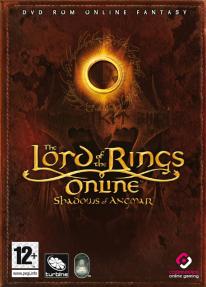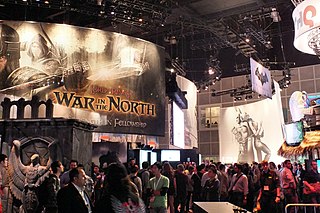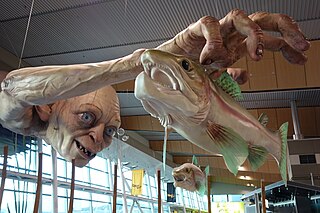
The Lord of the Rings is an epic high fantasy novel by the English author and scholar J. R. R. Tolkien. Set in Middle-earth, the story began as a sequel to Tolkien's 1937 children's book The Hobbit, but eventually developed into a much larger work. Written in stages between 1937 and 1949, The Lord of the Rings is one of the best-selling books ever written, with over 150 million copies sold.

Tom Bombadil is a character in J. R. R. Tolkien's legendarium. He first appeared in print in a 1934 poem called "The Adventures of Tom Bombadil", which also included The Lord of the Rings characters Goldberry, Old Man Willow and the Barrow-wight, from whom he rescues the hobbits. They were not then explicitly part of the older legends that became The Silmarillion, and are not mentioned in The Hobbit.
Celebrimbor is a fictional character in J. R. R. Tolkien's legendarium. His name means "silver fist" or "hand of silver" in Tolkien's invented language of Sindarin. In Tolkien's stories, Celebrimbor was an elven-smith who was manipulated into forging the Rings of Power by the Dark Lord Sauron, in fair disguise and named Annatar. Sauron then secretly made the One Ring to gain control over all the other Rings and dominate Middle-earth, setting in motion the events of The Lord of the Rings.
The following outline is provided as an overview of and topical guide to the real-world history and notable fictional elements of J. R. R. Tolkien's fantasy universe. It covers materials created by Tolkien; the works on his unpublished manuscripts, by his son Christopher Tolkien; and films, games and other media created by other people.

Krome Studios Melbourne, originally Beam Software, was an Australian video game development studio founded in 1980 by Alfred Milgrom and Naomi Besen and based in Melbourne, Australia. Initially formed to produce books and software to be published by Melbourne House, a company they had established in London in 1977, the studio operated independently from 1987 until 1999, when it was acquired by Infogrames, who changed the name to Infogrames Melbourne House Pty Ltd.. In 2006 the studio was sold to Krome Studios.
Middle-earth Enterprises, formerly known as Tolkien Enterprises, is a subdivision of the Embracer Freemode division of Embracer Group and formerly a trade name for a division of The Saul Zaentz Company. The subdivision owns the worldwide exclusive rights to certain elements of J. R. R. Tolkien's two most famous literary works: The Hobbit and The Lord of the Rings. These elements include the names of characters contained within as well as the names of places, objects and events within them, and certain short phrases and sayings from the works.

The Lord of the Rings Online is a massively multiplayer online role-playing game (MMORPG) for Microsoft Windows and OS X set in J. R. R. Tolkien's Middle-earth, taking place during the time period of The Lord of the Rings. Originally developed by Turbine, the game launched in North America, Australia, Japan, and Europe in April 2007 as The Lord of the Rings Online: Shadows of Angmar. Players could create characters of four races and seven classes and adventure throughout the region of Eriador. In November 2008, the Mines of Moria expansion was released, adding the region of Moria and two new playable classes. It was followed by the Siege of Mirkwood in December 2009. In 2010 the game underwent a shift from its original subscription-based payment model to being free-to-play.

The Lord of the Rings: The Fellowship of the Ring is a 2002 action-adventure video game developed by WXP for the Xbox. It was ported to the Game Boy Advance by Pocket Studios and the PlayStation 2 and Microsoft Windows by Surreal Software. The game was published by Vivendi Universal Games under their Black Label Games publishing label. In North America, it was released for Xbox and Game Boy Advance in September, and for PlayStation 2 and Windows in October. In Europe, it was released for Xbox, Windows and Game Boy Advance in November, and for PlayStation 2 in December.

The Hobbit is an illustrated text adventure computer game released in 1982 for the ZX Spectrum home computer and based on the 1937 book The Hobbit, by J. R. R. Tolkien. It was developed at Beam Software by Philip Mitchell and Veronika Megler and published by Melbourne House. It was later converted to most home computers available at the time including the Commodore 64, BBC Micro, and Oric computers. By arrangement with the book publishers, a copy of the book was included with each game sold.

Lord of the Rings is a cooperative board game based on the high fantasy novel The Lord of the Rings by J. R. R. Tolkien. Published in 2000 by Kosmos in Germany, Wizards of the Coast in the U.S., and Parker Brothers in the U.K., the game is designed by Reiner Knizia and features artwork by illustrator John Howe. In the game, each player plays a hobbit in the party, and the party will aim to destroy the One Ring. Upon its release, the game received a Spiel des Jahres special award. A slightly revised version was later published by Fantasy Flight Games.

There are many video games that have been inspired by J. R. R. Tolkien's works set in Middle-earth. Titles have been produced by studios such as Electronic Arts, Vivendi Games, Melbourne House, and Warner Bros. Interactive Entertainment.

Shadows of Mordor: Game Two of Lord of the Rings is a text adventure game for the Commodore 64, Amstrad CPC, ZX Spectrum, Apple II, DOS, and Macintosh. It is based on the second part of The Lord of the Rings story. It's a sequel to Lord of the Rings: Game One and The Hobbit.
Many adaptations of The Lord of the Rings, an epic by the English author J. R. R. Tolkien, have been made in the media of film, radio, theatre, video games and recorded readings.
The first authorised adaptation of J. R. R. Tolkien's 1937 novel The Hobbit was a stage production by St. Margaret's School, Edinburgh in March 1953. Subsequently, The Hobbit has been adapted for a variety of media including stage, screen, radio, board games and video games.

Gollum is a fictional character in J. R. R. Tolkien's Middle-earth legendarium. He was introduced in the 1937 fantasy novel The Hobbit, and became important in its sequel, The Lord of the Rings. Gollum was a Stoor Hobbit of the River-folk who lived near the Gladden Fields. In The Lord of the Rings it is stated that he was originally known as Sméagol, corrupted by the One Ring, and later named Gollum after his habit of making "a horrible swallowing noise in his throat".

The Fellowship of the Ring is the first of three volumes of the epic novel The Lord of the Rings by the English author J. R. R. Tolkien. It is followed by The Two Towers and The Return of the King. The action takes place in the fictional universe of Middle-earth. The book was first published on 29 July 1954 in the United Kingdom. The volume consists of a foreword, in which the author discusses his writing of The Lord of the Rings, a prologue titled "Concerning Hobbits, and other matters", and the main narrative in Book I and Book II.

Middle-earth: Shadow of Mordor is a 2014 action-adventure video game developed by Monolith Productions and published by Warner Bros. Interactive Entertainment. An original story based on the legendarium created by J. R. R. Tolkien, the game takes place between the events of The Hobbit and The Lord of the Rings film trilogies. The player controls Talion, a Gondorian Ranger who bonds with the wraith of the Elf Lord Celebrimbor, as the two set out to avenge the deaths of their loved ones. Players can engage in melee combat, and use wraith abilities to fight and manipulate enemies. The game introduces the Nemesis System, which allows the artificial intelligence of non-playable characters to remember their prior interactions with Talion and react accordingly in subsequent encounters.

Belegost is a 1989 Czech text adventure for the ZX spectrum and Atari ST. It is considered part of the textovka genre—the Czechoslovak text adventure industry.

The Lord of the Rings: Gollum is an action-adventure game developed by Daedalic Entertainment, which also published the game with Nacon. The game, set in the fictional world of Middle-earth created by J. R. R. Tolkien, takes place in between the events of The Hobbit and The Fellowship of the Ring. The player controls Gollum through a series of locations, such as Cirith Ungol, Barad-dûr, and Mirkwood, as he attempts to find Bilbo Baggins and retake the One Ring whilst battling and avoiding Sauron. It was announced in March 2019 and delayed from its September 2021 launch window.















